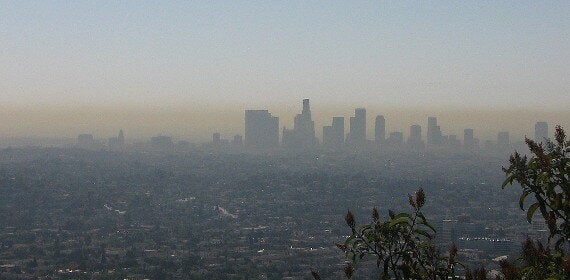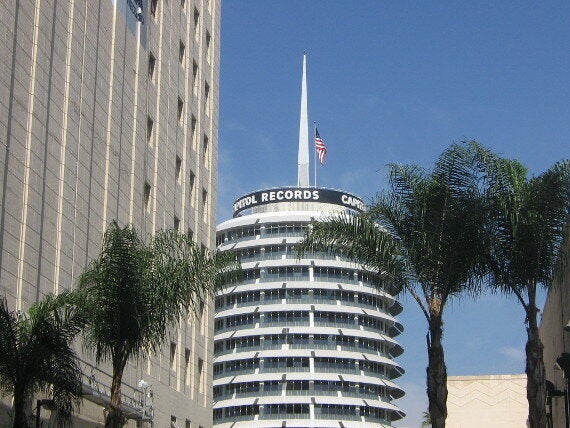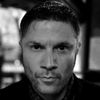"Hugh Hefner owns the letter Y," says the studio guide, and together we squint to better see the word writ large upon the distant hillside: Hollywood, a word connoting enterprise, community and stardom and which underpins this vast, sprawling city.

Los Angeles is two cities: one of the rarefied film world whose players live secluded in the Hollywood hills; the other the working city, populated by panhandlers, grifters and grafters, the wide boulevards down which course the cabs, limos and fender-bent Fords in a twilight that could be early morning or the dim mauve of after sunset.
This is no longer Raymond Chandler's town. Instead, it's a city of opportunity. The lean of lofty palms towards the sun, like Los Angelinos themselves, is a sign of the quiet ambition that feeds the city's creativity.
At Capitol Records there's evidence of it in Welton Becket's landmark office and studio complex on Vine Street once utilised by the likes of Frank Sinatra, Nat King Cole and The Beach Boys, while up west at the Richard Meier-designed Getty Center - where the parapet's rail shudders as another minor earth tremor, unfelt by most, spasms through the rock - there's the spare and wonderful exhibition Josef Koudelka: Nationality Doubtful, a collection of photographs that takes in the 1968 invasion of Prague, a study of Romany gypsies and the timeless form of European and Levantine antiquity. In LA, it's a nourishing sight and is no less essential than what can be found in the Museum of Contemporary Art (MOCA) which proffers the monumental Andy Warhol's 102-part painting, Shadows (1978-79).
LA, it would appear, is a city of surprises, hooked on imagery, light and space and humming with artistic activity borne of a famed West Coast acumen. The photographic art of a gallery like the Getty Center somehow helps echo the city's vistas with the stark monochrome of an artist's foreign canvas.
A cab takes you to Sunset and you amble down to North Cahuenga Boulevard to pay homage to the legendary Shelly Manne jazz club, Shelly's Manne-Hole, where the likes of Miles Davis and Tubby Hayes once performed.
Two doors along and musical history overwhelms you with the discovery of Wally Heider's studio (now a coffee shop) where everyone from Bowie, Macca, Hendrix, Zappa, Marvin, Clapton, The Doors and The Who recorded. The landmark evokes the photographic presence of the names inscribed on the plaque by the door and the LA experience segues from imagery to music. Everything, somehow, leads back to celluloid.
The ground gets more fertile by the moment. This is definitely not Chandler's LA. Catch the metro and be exiled on the corner of 4th and Main streets and you come across the corner on which Woody Guthrie first sang between stints as a dish washer and sign painter. Guthrie sang of California as a garden of Eden. He might yet be proved right. It's LA and you capture him in your mind's eye.
As flat as a table top, LA rises up from LAX towards the peaks of the high desert, the scant few skyscrapers of Downtown grouped like so many stickle bricks lonely in the haze and dry air. And while Downtown is being gentrified, it yet evokes the regions of memory that know nothing of time, the worn-out look of the theatre district in need only of a lick of paint that would restore it to its post-Depression charm and bustle. Again, the imagined image is framed, made permanent.
LA is a metropolis with film crews on every corner, LAPD cruisers idling nearby, watching over proceedings. Opportunity knocks. The young guitarist back west on Hollywood Boulevard, drenched in the neon of hope and straight in off the Greyhound from Houston, plays blues licks like Hendrix as if his life depends on it.
Diners the city over rub shoulders with modern film stars and the ghosts of Dashiell Hammett, F Scott Fitzgerald and Chandler himself in wood-panelled restaurants that were once the haunts of some of the greatest actors and writers of the 20th century. It's LA as a hive of remembrance and visitation, where the encumbered come to be free, where your camera eye captures beauty with each stolen glance.

Art blooms wildly in local galleries, almost without restraint like the local Bird of Paradise, the city itself a stage set, the mountains that ring it almost too beautiful to be real.
From the John C. Austin-designed Griffith Observatory, the haze half a mile thick hangs over the city like a thatched roof. And like stars of the screen, the city has attracted architects: Barnsdall Art Park is topped by a Frank Lloyd Wright masterpiece, Hollyhock House; an architect who, like Frank Gehry and Renzo Piano, found the city's light and space irresistible for experimentation.
The flocks of birds and honk of car horns proclaim that LA is a city alive, disproving its detractors. And still they come in search of the dream. You snake east from the theatre district and polished surface of the lake in MacArthur Park that gleams like steel, and make your way along Wilshire Boulevard where examples of art deco architecture stand pristine like mausoleums, pagan and impregnable.
No, it's no longer Chandler's LA, but instead a city undergoing constant social and artistic evolution, one that makes its own entertainment while being culturally more attuned to Asia Pacific and Latin America than to anything remotely European.
It's way out west on the ocean's lip. It's as far as we've come and a measure of how far we must yet go. It's the city of angels, of industry and its ground shakes with the trudge of men and women who make anew the immigrant experience of old, their hands the hands of those who build a new America.
Photographs by @JasonAHolmes
